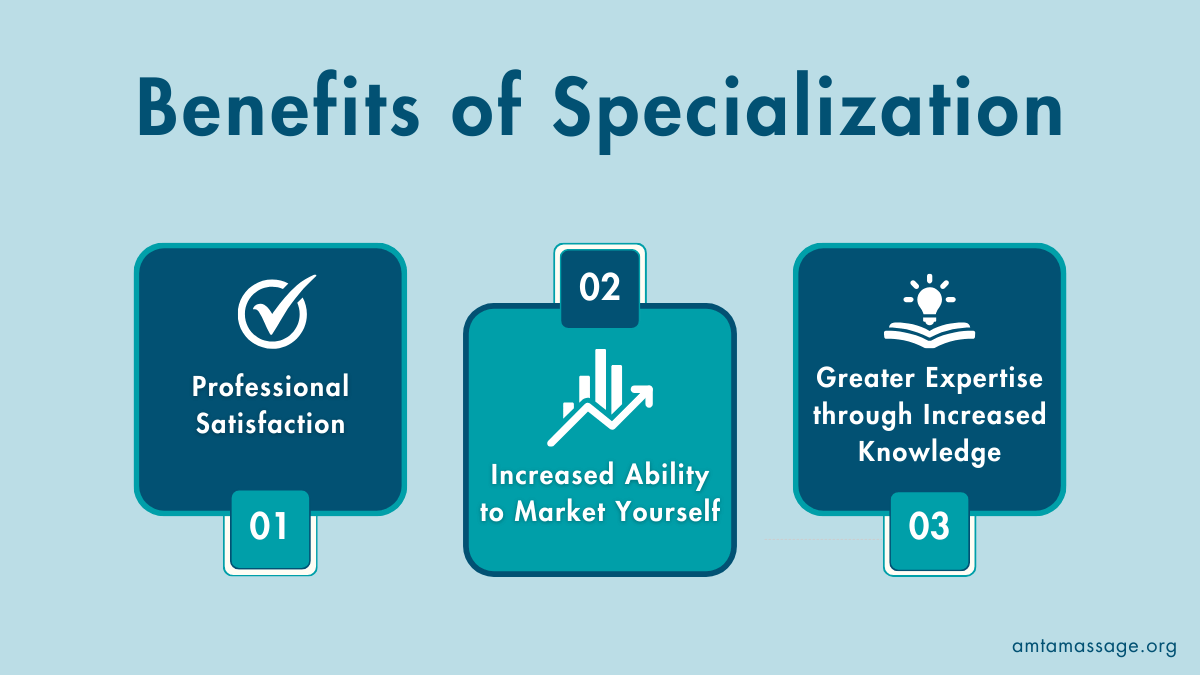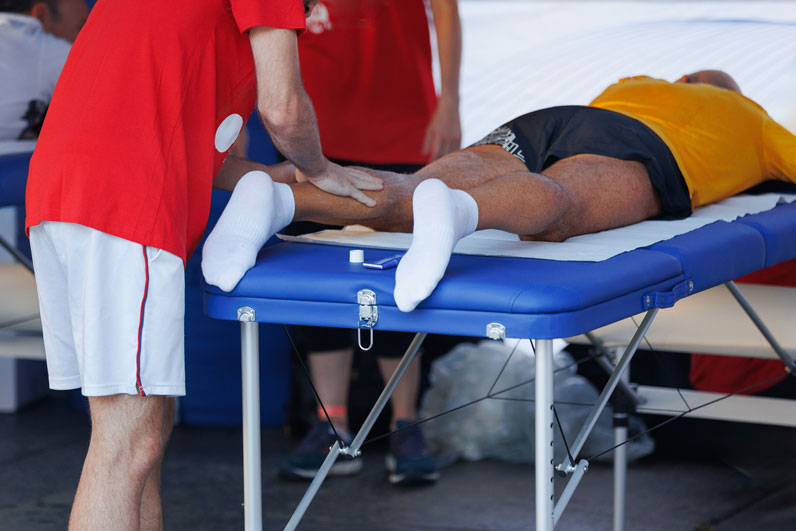AMTA Member Benefit
Find A Massage Therapist
Don't forget to list yourself in AMTA's Find a Massage Therapist National Locator Service!
Choosing a specialization for your massage therapy practice comes with a host of benefits, but you need to find what is right for you.
November 1, 2024

To specialize or not to specialize? As a massage therapist in a growing profession that continues to see research support and expand on the benefits massage therapy offers, you have a variety of opportunities to create a focused niche for your practice, like Thai Massage, prenatal massage and sports massage, to name a few.
But, is specialization right for you? Or, would a more general practice with more client variety be more professionally satisfying?
No matter where you are on your career path, periodically asking yourself these questions can keep you continually inspired and engaged in the massage profession, and help you refine nearly every aspect of your practice, from continuing education choices to marketing efforts to the clients you choose.
There are benefits to both a broader approach to your practice and viewing your practice through a more focused lens. Here, we’ll break out some of the reasons specialization might work for you, as well as different massage practice areas you might consider.
When thinking about the value of specializing, Bruce Lee may have said it best: “I fear not the man who has practiced 10,000 kicks once, but I fear the man who has practiced one kick 10,000 times.”
Specialization gives massage therapists the opportunity to build a reputation as an expert, which can mean clients may be more keen to seek out your services.
Professional satisfaction. Not only can expertise draw clients to a practice, but massage therapists who are known for specialized services can sometimes command higher rates. Additionally, by choosing to specialize in something either well-known or trending, massage therapists can help ensure they stay engaged with their work and the broader profession.
More focused marketing. Specialization can also make it easier for you to market yourself. When you can show potential clients you have specialized knowledge and understanding, the ability to build trust is enhanced.
For example, if you focus your practice on prenatal massage and can showcase the continuing education and years of experience you have working with people who are pregnant, potential clients will more likely trust your expertise.
Valuable expertise. Finally, specialization can lead to better client outcomes because of the increased knowledge and experience you have in a specific area. One way to gain this expertise is via continuing education courses.

Increasing your knowledge through high-quality continuing education is a great way to make sure you’re staying up to date and relevant, and also means you can talk to current and future clients about the rigor of the courses you pursue, another way to build trust.
When you’re thinking whether or not specialization is right for you, consider some of the following:
“I am a sole practitioner focusing on clinical applications of massage for clients wishing to reduce pain or improve their range of motion,” says Steve Albertson, LMT. “Prior to becoming a massage therapist, I worked as a fire department paramedic, a medical product researcher and a technical specialist for two different engineering schools. I have always embraced creative problem solving, knowledge of the human body and the ability to positively impact the lives of others. Focusing on clinical applications of massage allowed me to draw on the expertise I had developed from those previous positions.”
There is no shortage of areas to specialize in within the massage therapy profession.
Some of the more common practices that may be ripe for specialization include:
Thai massage, also known as Nuad Bo-Rarn, is an ancient practice that originated in Thailand and is traditionally performed on a mat on the floor with the client dressed in comfortable clothing. This type of massage therapy is considered a combination of acupressure, passive stretching and rhythmic compressions that focuses on promoting overall well-being and balance in the body.

Once considered a more unique modality, Thai massage has become fairly mainstream and widely accepted. This increased awareness has led more massage therapists to pursue continuing education in Thai massage.
“Practiced properly, Thai massage is said to be equally beneficial for the giver and receiver,” explains Jill Burynski, president and founder of Living Sabai School of Thai Massage. “Massage therapy can be a physically strenuous occupation. Many massage therapists exit the profession earlier than they had hoped because of repetitive stress injuries and wear and tear on their bodies.”
Due to its ergonomic body mechanics that are reminiscent of martial arts—as well as the use of gravity and leverage rather than force—Thai massage can help prevent the repetitive stress injuries and physical burnout that are all too common among massage therapists. Thai massage work also incorporates many hand-saving tools, such as Tok Sen, Herbal Compress and Pa Kao Mah sarongs.
Who might be interested? For veteran massage practitioners who are looking for techniques that are easier on their bodies and may help extend their career longevity, Thai massage may be a great specialization.
Sports leagues are multibillion dollar organizations with multimillion dollar athletes. For the health of the team (and individual athletes) and success of the season, finding ways to keep physical and mental well-being a top priority is becoming increasingly more important to professional sports leagues.
Today, professional sports teams spare no expense on their training and recovery facilities and offerings to keep their athletes performing at their best, and sports massage therapy is included as part of these offerings for just about every pro sports team.

One of the biggest differences between a professional athlete and a traditional massage client is body type. “The biggest difference is size and muscle mass,” says Cicily Cannady, a massage therapist who has worked with the NFL’s Jacksonville Jaguars since 2017. “The players that have a lot of muscle mass take a lot more care and time warming up the tissues and manipulating the muscle to promote circulation and flexibility.”
The work environment is also different. “I typically do home visits for my everyday clients,” explains Julia Brimley, a massage therapist who has been working with the NBA’s Brooklyn Nets since 2020 and the NFL’s New York Jets since 2022. “The environment is usually private. Whereas in professional sports, they have one big room for treatment, which can include massage therapists, physical therapists, athletic trainers and chiropractors.”
What does this mean for you? You may find yourself massaging one athlete on one table while another athlete in the same room might be receiving compression treatment or chiropractic adjustments.
Additionally, when working as a massage therapist in a professional sports setting, teamwork is not only beneficial but required. “I work hand-in-hand with the athletic trainer,” says Jessica Satti, a massage therapist with the WNBA’s Connecticut Sun. “She will give me a recap of what is going on with each player before they are on my table. I will always watch their away games to help me see things that happened on the court.”
Similarly, Brimley makes note of the importance of both relying on the information from other health care providers around her, as well as informing them of her own findings.
Who might be interested? Practicing massage in a professional sports setting may appeal to massage therapists who are already interested in sports massage, enjoy working in a faster paced environment, and who like to collaborate with other professions as part of a larger team.
Generally defined, pregnancy massage—also sometimes referred to as prenatal massage—is a massage focused on helping people who are pregnant. “Prenatal massage is performed much like any other massage,” says Julia Costello, licensed massage therapist and owner of Portland Prenatal Massage.
The strokes and techniques used during prenatal massage are very similar to Swedish massage, though there are some key differences. With prenatal massage, for example, strokes may be slower and gentler, and may include techniques like feathering and craniosacral therapy. Additionally, certain areas, such as the calves, may require caution because of the increased risk of blood clots.
“Therapeutic touch, gentle range of motion, and breath work can all help the mother’s nervous system shift and help her adjust to the many changes taking place,” says Danielle Dickey-Heifets, a licensed massage therapist.

Many massage therapists who regularly see or want to see more clients who are pregnant consider taking advanced continuing education on the topic to stay updated on the latest research and ensure they continue to practice safely.
Who might be interested? Pregnancy massage may be interesting to massage therapists who have a passion for helping women better deal with the multitude of issues that can arise during pregnancy and want to focus more of their practice on this client demographic.
Regardless of the specialization a massage therapist may choose, there are some things that are true for everyone. “No matter what area of massage therapy you pursue, try to avoid working in isolation,” says Albertson. “Collaborate with others whenever you can. Stay current on the latest research within our field.”
When you’re considering whether specializing might be a good career choice for you, the following questions may help simplify the process by narrowing down your skills, interests and career goals.
1. What are my interests and passions within the massage therapy profession?
2. What types of massage techniques do I enjoy practicing the most?
3. What populations or demographics do I feel drawn to working with (e.g., athletes, pregnant people, elderly)?
4. What are the specific needs or issues that I want to address through massage therapy (e.g., pain management, stress relief, rehabilitation)?
5. What are my strengths and areas of expertise within massage therapy (e.g., deep tissue massage, Swedish massage, aromatherapy)?
6. What additional training am I willing to pursue to specialize in a certain area?
7. What are the demands and opportunities for different specializations in my local area or desired market?
8. What is the income potential and job prospects for various specializations in massage therapy?
9. How do I envision my career evolving in the future, and which specialization aligns best with those aspirations?
10. What feedback or encouragement have I received from clients, colleagues or mentors regarding my aptitude for certain types of massage or working with specifc populations?
______________________________
Share Your Feedback on Massage Therapy Journal
Take our quick survey to share your insights and help us enhance our publication!